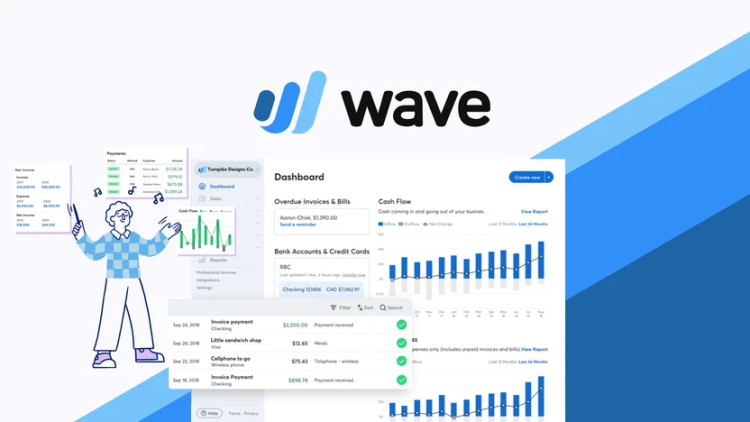Who should create invoices in Wave — the client or the freelancer managing their accounts? And how does Wave support this workflow?
This blog explores whether clients or freelancers should be responsible for creating invoices when using Wave Accounting. It outlines both workflows — client-managed and freelancer-managed invoicing — along with their benefits, challenges, and use cases. The post explains how Wave’s multi-user access, business profiles, invoicing automation, and payment features support flexible, collaborative accounting for freelancers managing multiple clients. It also highlights the value of hybrid models that combine control with accuracy. Freelancers using Wave Accounting: Should you or your clients create invoices? Explore both invoicing workflows, pros, cons, and how Wave supports seamless collaboration and accurate bookkeeping.

Who Should Create Invoices in Wave — The Client or the Freelancer Managing Their Accounts? And How Does Wave Support This Workflow?
Introduction
In the world of freelance bookkeeping and virtual accounting, one question often arises:
Who should be responsible for creating client invoices — the client themselves or the freelancer managing their accounts?
If you're using Wave Accounting, you’ve already chosen a smart and beginner-friendly platform that simplifies invoicing, payments, and bookkeeping. But this question is about workflow ownership, accountability, and accuracy. Whether you’re a freelancer offering complete financial services or just managing backend accounting, it’s important to decide who will handle invoicing — and how Wave supports either path.
In this blog post, we’ll explore both roles in detail, break down the pros and cons of each approach, and help you choose what works best for your business model. You’ll also discover how Wave’s multi-user features, automation, and reporting tools can support either (or both) workflows with clarity and control.
Understanding the Role of Invoicing in Accounting
Before we address who should create the invoices, let’s first understand why invoicing is such a critical task in financial workflows:
-
It’s the first step in recognizing income
-
It sets the timeline for cash flow (when to expect payments)
-
It becomes the foundation for accounts receivable
-
It links directly to bookkeeping, taxes, and client reporting
If invoices are incorrect, incomplete, or inconsistent, it can lead to:
-
Delayed or missed payments
-
Accounting mismatches
-
Customer confusion
-
Financial reporting errors
Hence, deciding who creates the invoices should be an intentional decision — not just a default one.
Two Common Workflows in Wave
Wave is built to accommodate both styles: the client-driven invoicing workflow and the freelancer-managed approach.
Option A: The Client Creates Their Own Invoices
In this setup, your client:
-
Logs into Wave using their account
-
Creates and sends invoices to their customers
-
Records payments or integrates payment options
-
You, the freelancer/bookkeeper, then handle the rest — categorizing, reconciling, reporting
Option B: The Freelancer Creates Invoices on Behalf of the Client
Here, you manage the entire invoicing process:
-
Set up customer profiles
-
Create and send invoices
-
Automate recurring billing
-
Track payments
-
Record income in the books
-
Share reports with the client
Both workflows are supported in Wave. Which one to choose depends on the client’s preference, your service offering, and how involved each party wants to be.
Workflow A: Client Creates Their Own Invoices
✅ When This Works Best:
-
The client prefers real-time interaction with their customers
-
They want to control branding, messaging, and timing
-
You’re hired mainly for backend bookkeeping, tax filing, or financial reports
-
They use Wave as their primary tool and want full ownership
???? Things to Consider:
-
You must regularly review their invoices for accuracy
-
Clients may forget to record payments properly
-
Mistakes in tax application or invoice details may lead to reporting errors
-
You might need to train them on proper usage
How Wave Supports This:
-
Each client can have their own Wave login
-
They can create and manage invoices anytime
-
You can be invited as a collaborator (Admin, Editor, Viewer)
-
You can access the books to clean up entries, reconcile accounts, and generate reports
-
The invoice and payment data flows directly into the books
Workflow B: Freelancer Handles Invoicing
✅ When This Works Best:
-
You offer full-service financial management
-
The client wants to be hands-off
-
Your client doesn’t have the time or skills to manage invoices
-
You need to control all financial data entry for accuracy
-
You’re managing multiple parts of their business (e.g., invoicing + expenses + payroll + taxes)
???? Things to Consider:
-
You need access to client details, service pricing, and customer info
-
Communication is needed to ensure invoice accuracy
-
If changes are needed urgently, clients may expect quick action
How Wave Supports This:
-
You can create multiple business profiles under your single Wave login
-
Each business is treated like a separate company — fully independent
-
You can create, schedule, and send invoices using Wave’s recurring invoicing feature
-
You can automate payment reminders, customize branding, and record payments
-
Online payments (via Stripe) can be enabled for fast processing
-
All invoicing data is instantly reflected in the accounting dashboard
Key Wave Features That Support Both Workflows
Whether the client or the freelancer creates the invoices, Wave offers powerful tools to streamline and manage the process:
1. Multi-User Access
Clients can invite you to collaborate on their Wave profile with roles like:
-
Viewer: View-only access
-
Editor: Can create invoices, categorize expenses, etc.
-
Admin: Full control
Or, you can manage the entire business profile under your Wave login if you’re handling multiple clients.
2. Recurring Invoicing
Invoices can be auto-sent on a schedule — weekly, monthly, etc. Great for retainer clients or subscription models.
3. Payment Integration
Wave supports online payments via Stripe or bank transfer. Payment status is auto-updated and logged in the books.
4. Templates & Branding
You (or your client) can design professional invoice templates with logos, colors, and notes.
5. Reminders & Notifications
Wave sends automatic reminders for upcoming and overdue invoices — helping reduce missed payments.
6. Mobile Access
Both parties can access Wave via mobile apps to track and manage invoices on the go.
Pros and Cons of Each Approach
| Workflow | Pros | Cons |
|---|---|---|
| Client-Created Invoices | Empowers client, real-time customer control, direct payment | Risk of errors, inconsistent formatting, requires oversight |
| Freelancer-Created Invoices | Accurate data, full integration with books, time-saving for client | Requires more input from client (service details), added responsibility |
Best Practice: Combine the Two
Many freelancers adopt a hybrid approach:
-
Clients provide the service details, pricing, or approvals
-
You create the invoices, send them, and track payments
-
You also handle bookkeeping and reporting
This way:
-
Clients stay informed and in control
-
You ensure accuracy and consistency in records
-
Both parties collaborate for efficient outcomes
A Freelancer Workflow in Action (Example)
Let’s say you’re managing finances for a freelance web designer.
-
Each week, they send you a summary of completed projects or hours
-
You create and send invoices via Wave
-
Customers pay via credit card
-
Wave records the payment in the books
-
You categorize expenses, reconcile bank transactions, and prep reports
-
At month-end, you send a financial summary to your client
All this happens without the client touching Wave directly — yet they receive professional billing, clean books, and peace of mind.
FAQs
Q: Can I switch between workflows later?
Yes. If a client starts creating their own invoices but later wants you to take over (or vice versa), you can easily adjust roles in Wave.
Q: Can both the client and freelancer create invoices in the same Wave profile?
Yes. If both parties have access, invoices can be created by either — just coordinate to avoid duplicates.
Q: Does Wave allow limited access?
Yes. You can be invited as an Editor or Viewer to a client’s account — or manage their business profile independently.
Q: What if the client uses another tool for invoicing?
If a client uses another platform (like Zoho, QuickBooks, or FreshBooks) for invoices, you can still use Wave solely for bookkeeping — but it adds manual work and potential errors.
Conclusion
So, who should create invoices in Wave — the client or the freelancer?
The answer depends on your working relationship, the client’s preferences, and the services you offer.
-
If the client wants control, let them handle invoicing and simply monitor the data
-
If the client prefers convenience and accuracy, take charge of both invoicing and bookkeeping
-
If you're aiming for full-service freelance financial management, handling both is usually better
Wave supports both models — offering automation, templates, reminders, and real-time syncing between invoices and accounting. With the right setup and communication, you can build a workflow that’s both efficient and client-friendly.
Whether you're just getting started or scaling your bookkeeping business, Wave’s flexibility allows you to choose the invoicing model that works best for you — and deliver financial clarity to every client you serve.
What's Your Reaction?






















